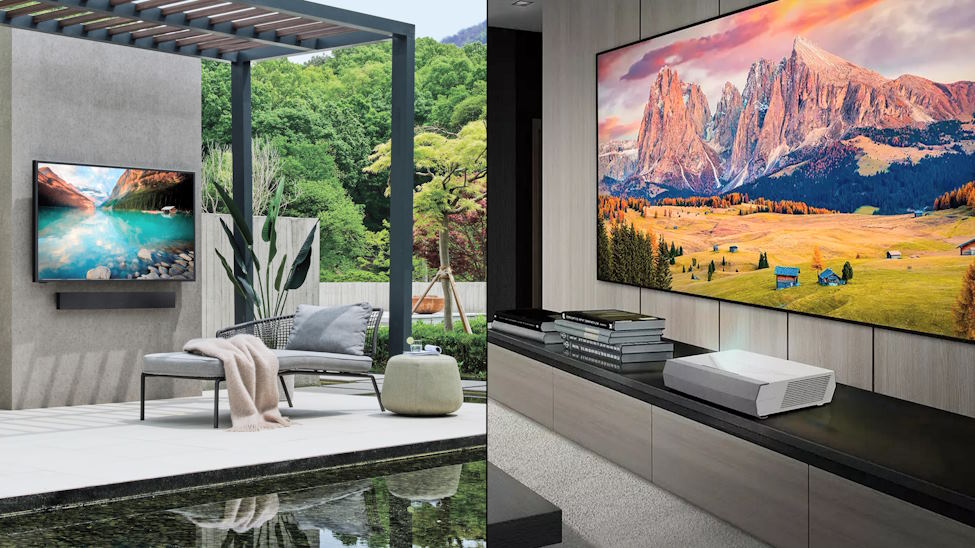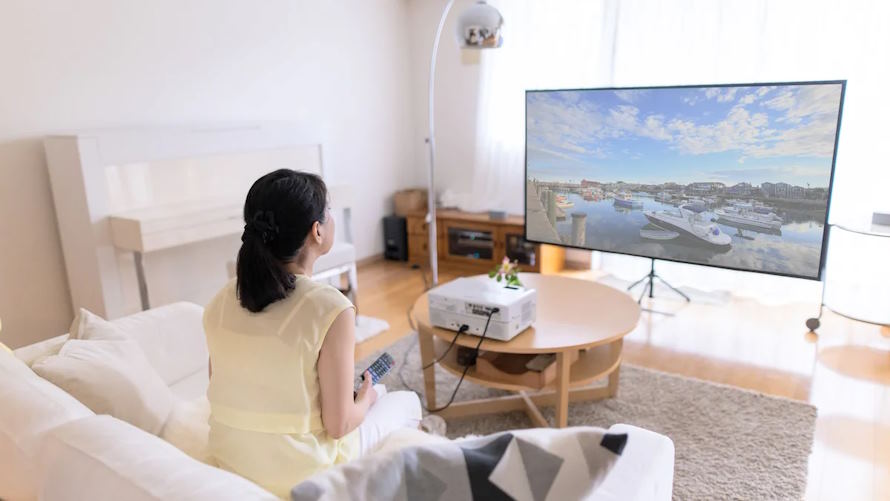As living rooms transform into mini cinemas and family gathering spots, the debate over projectors versus TVs takes center stage. The advent of cutting-edge display technologies, coupled with an array of features, has blurred the lines between these two home entertainment powerhouses. From the grandeur of large-scale projections to the sleek sophistication of modern TVs, we embark on a journey to help readers determine which technology aligns best with their home theater aspirations. Whether you’re a tech-savvy enthusiast or a casual viewer, the decision between projectors and TVs plays a pivotal role in shaping the very heart of your home entertainment experience.
Picture Quality: Unveiling the Canvas of Visual Excellence
Projectors
- Advantages in terms of larger screen size: One of the crowning glories of projectors lies in their ability to transform your living space into a cinematic haven. The sheer expansiveness of the screen is a game-changer, offering an immersive experience that transports you into the heart of the action. From breathtaking landscapes to heart-pounding action sequences, projectors excel in providing a larger-than-life canvas that captivates the senses.
- High-end projectors and their advanced display technologies: The pinnacle of projection technology brings forth high-end projectors equipped with advanced display technologies. From 4K resolution to laser and DLP technologies, these projectors redefine visual fidelity. The result is a level of detail and clarity that elevates the home viewing experience, making every frame a visual masterpiece.
- Consideration of ambient light conditions: While projectors shine in dimly lit environments, considerations for ambient light conditions are crucial. Optimal performance often requires a controlled lighting setup, ensuring that the projector’s brilliance isn’t diluted. The strategic placement of blackout curtains or blinds becomes imperative, allowing you to tailor the environment for an unparalleled visual feast.
- Image sharpness and color accuracy: Projectors boast impressive image sharpness and color accuracy, essential for cinephiles and avid gamers alike. High-quality lenses and color processing technologies work in tandem to reproduce vivid hues and sharp details. The result is a visual spectacle where every nuance is preserved, from the subtlest shades to the sharpest contours.
TVs
- Consistent and vibrant colors: TVs, with their compact and self-contained nature, excel in delivering consistent and vibrant colors. The inherent ability of LED and OLED panels to reproduce a wide spectrum ensures that each frame is a burst of life, offering an uncompromising visual feast right in the comfort of your living room.
- HDR capabilities and contrast ratios: High Dynamic Range (HDR) technology is a trump card for TVs, enhancing contrast ratios and delivering a visual dynamism that brings scenes to life. Whether it’s the deepest blacks or the brightest whites, HDR on TVs elevates the viewing experience, especially when paired with content designed to exploit its full potential.
- Impact of screen size on perceived picture quality: TVs present a more straightforward relationship between screen size and perceived picture quality. With consistent panel technology across various sizes, TVs ensure that the visual integrity remains intact, making them a reliable choice for those who prioritize size without compromising on visual fidelity.
- Reflection and glare issues: TVs shine in well-lit rooms, but reflections and glare can be potential pitfalls. Careful consideration of room lighting and strategic placement can mitigate these concerns. Anti-glare technologies in modern TVs also contribute to an improved viewing experience, allowing you to enjoy content without unwanted distractions.
Audio Considerations: Elevating the Sonic Symphony
Projectors
- Built-in speaker quality: Projectors often come equipped with built-in speakers, but their quality may vary. While suitable for casual viewing, cinephiles and audiophiles may find themselves yearning for a richer auditory experience. The built-in speakers serve as a baseline, but for a true sonic journey, external audio solutions become imperative.
- External audio system options: Unlocking the full potential of your projector’s visuals demands an external audio system. Whether it’s a robust soundbar or a full-fledged home theater audio setup, external speakers complement the grandeur of the projected visuals, delivering a harmonious fusion of sight and sound.
- Surround sound compatibility: For a truly immersive cinematic experience, projectors often support surround sound systems. Surround sound adds depth and realism to audio, making you feel like you’re in the midst of the action. Compatibility with formats like Dolby Atmos ensures a three-dimensional audio experience that complements the visual spectacle.
- Importance of dedicated audio setup for immersive experience: To achieve the pinnacle of immersion, a dedicated audio setup is paramount. Projectors, with their ability to create expansive visuals, truly come to life when coupled with a powerful audio system. The symphony of high-quality visuals and immersive sound transports viewers to the heart of their favorite movies or games, creating an unforgettable experience.
TVs
- Built-in soundbar or speaker quality: Modern TVs often boast built-in soundbars or high-quality speakers, offering a decent audio experience out of the box. The advancements in TV audio technology provide clear dialogue and a balanced audio profile, suitable for everyday viewing.
- External audio connectivity options: TVs extend their versatility by offering various external audio connectivity options. From HDMI ARC to optical and Bluetooth connections, users can easily integrate additional audio devices, enhancing the overall sound quality based on individual preferences.
- Surround sound support: TVs, especially those designed for home entertainment, frequently support surround sound technologies. This feature ensures that users can recreate a cinematic audio experience right at home. Pairing a TV with a surround sound system transforms the living room into a mini theater, captivating audiences with immersive audio.
- Evaluating the need for a separate audio system: While TVs often deliver satisfactory audio, the need for a separate audio system depends on personal preferences and the desired level of immersion. Audiophiles and those seeking a cinematic audio experience may opt for external solutions, while others might find the built-in audio sufficient for everyday use.




